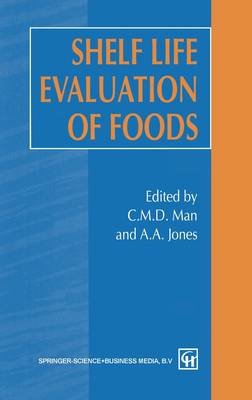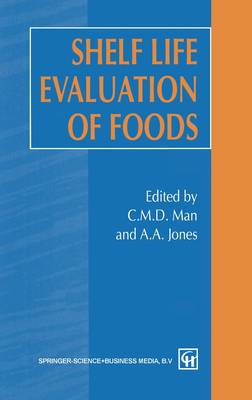
- Afhalen na 1 uur in een winkel met voorraad
- Gratis thuislevering in België vanaf € 30
- Ruim aanbod met 7 miljoen producten
- Afhalen na 1 uur in een winkel met voorraad
- Gratis thuislevering in België vanaf € 30
- Ruim aanbod met 7 miljoen producten
Zoeken
Omschrijving
1 - The principles.- 1 Scientific principles of shelf life evaluation.- 1.1 Introduction.- 1.2 Major modes of food deterioration.- 1.2.1 Physical changes.- 1.2.2 Chemical changes.- 1.2.3 Microbiological changes.- 1.3 Evaluation of food quality.- 1.3.1 Reaction kinetics.- 1.3.2 Determination of kinetic parameters.- 1.3.3 Shelf life plots.- 1.4 Use of sensors to monitor shelf life of foods.- 1.4.1 Critical temperature indicators.- 1.4.2 Partial history indicators.- 1.4.3 Full history indicators.- 1.5 Conclusions.- References.- 2 The methodology of shelf life determination.- 2.1 Integration of shelf life procedures into a total quality system.- 2.2 Food legislation and shelf life.- 2.3 Forms of quality deterioration during storage.- 2.4 Procedures for direct determination and monitoring of shelf life.- 2.5 Methodology for accelerated estimation of shelf life.- 2.6 The importance of shelf life to quality and distribution.- 2.7 Conclusions.- References.- 3 The principles and practice of shelf life prediction for microorganisms.- 3.1 Introduction.- 3.2 Development of predictive models.- 3.2.1 Experimental design.- 3.2.2 Data collection.- 3.2.3 Modelling.- 3.2.4 Model validation.- 3.2.5 Obtaining predictions.- 3.3 Uses of models.- 3.3.1 Product formulation and reformulation.- 3.3.2 Process design.- 3.3.3 HACCP.- 3.3.4 Time-temperature profiles.- 3.3.5 Training and education.- 3.4 Limitations of models.- 3.5 The future.- References.- 4 Packaging and food quality.- 4.1 Introduction.- 4.2 Plastics packaging materials for food.- 4.2.1 Polyolefins.- 4.2.2 Polyvinyl chloride (PVC).- 4.2.3 Polyvinylidene chloride (PVdC).- 4.2.4 Ethylene vinyl alcohol (EVOH).- 4.2.5 Polystyrene (PS).- 4.2.6 Polyamides (nylons).- 4.2.7 Polyesters.- 4.2.8 Polycarbonates (PC).- 4.2.9 Lamination and coextrusion.- 4.3 Some packaging systems and recent developments.- 4.3.1 Trends in food packaging.- 4.3.2 Silica-coated films.- 4.3.3 Active packaging technologies.- 4.3.4 Modified atmosphere packaging (MAP).- 4.3.5 Aseptic/ultra-high temperature (UHT) packaging.- 4.3.6 Sous vide (vacuum cooking/packaging) technology.- 4.3.7 Edible films.- 4.4 The influence of 'scalping' on food.- 4.4.1 The limonene controversy.- 4.4.2 The influence of pulp content on scalping.- 4.4.3 Comparison of instrumental and sensory analysis.- 4.4.4 Influence of scalping on barrier and mechanical properties.- 4.4.5 Methods of suppressing scalping.- 4.5 Flavour transfer problems in refillable PET bottles.- 4.6 Conclusions.- References.- 5 Preservation technology and shelf life of fish and fish products.- 5.1 Introduction.- 5.2 Properties and spoilage of fish.- 5.3 Conventionally preserved fish and fish products.- 5.4 Modern technologies.- 5.5 Sensory quality and safety.- 5.6 Conclusions.- 2 - The practice.- 6 Delicatessen salads and chilled prepared fruit and vegetable products.- 6.1 Introduction.- 6.2 The products - their characteristics.- 6.3 Specific factors affecting shelf life.- 6.3.1 Delicatessen salads.- 6.3.2 Prepared fruit and vegetables.- 6.4 Determination of shelf life.- 6.4.1 Delicatessen salads.- 6.4.2 Prepared fruit and vegetables.- 6.5 Current developments and the future.- 6.5.1 Delicatessen salads.- 6.5.2 Prepared fruit and vegetables.- References.- 7 Chilled yogurt and other dairy desserts.- 7.1 Introduction.- 7.2 Products, product groups and characteristics.- 7.2.1 Product groups.- 7.2.2 Product characteristics.- 7.3 Factors affecting shelf life.- 7.3.1 Raw materials.- 7.3.2 Processing.- 7.3.3 Filling and packaging.- 7.3.4 Storage and distribution.- 7.3.5 Consumer storage.- 7.4 Evaluation methods.- 7.4.1 Shelf life determination - yogurt.- 7.5 Current developments and the future.- 8 Modified-atmosphere-packed ready-to-cook and ready-to-eat meat products.- 8.1 Introduction.- 8.2 Meat product groups and their basic characteristics.- 8.2.1 Appearance.- 8.2.2 Flavour.- 8.2.3 Texture.- 8.3 Factors affecting shelf life.- 8.3.1 Intrinsic factors.- 8.3.2 Extrinsic factors.- 8.4 Det...
Specificaties
Betrokkenen
- Auteur(s):
- Uitgeverij:
Inhoud
- Aantal bladzijden:
- 342
- Taal:
- Engels
Eigenschappen
- Productcode (EAN):
- 9780751400335
- Verschijningsdatum:
- 31/12/1995
- Uitvoering:
- Hardcover
- Formaat:
- Genaaid
- Afmetingen:
- 165 mm x 241 mm
- Gewicht:
- 766 g

Alleen bij Standaard Boekhandel
+ 302 punten op je klantenkaart van Standaard Boekhandel
Beoordelingen
We publiceren alleen reviews die voldoen aan de voorwaarden voor reviews. Bekijk onze voorwaarden voor reviews.








